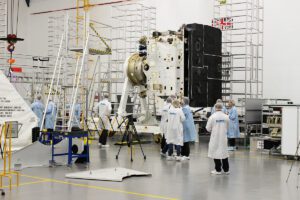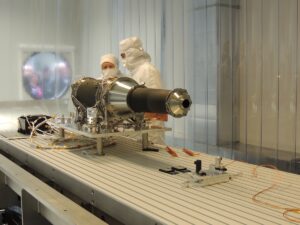
Berlin, 10 August 2021. – Solar Orbiter is the ESA/NASA mission launched on February 10, 2020, meant to observe the polar regions of the Sun down to 0.28 AU distance (42 million kilometres). It carries 10 instruments to investigate how our Star generates and controls the heliosphere.
The mission had yesterday (August 9th) the second encounter with Venus (the first flyby was on December 2020), this second one will allow the spacecraft to continue its journey towards the Sun.

Catia Grimani is an associate professor at the University of Urbino Carlo Bo (Italy) and is Co-Investigator and leader of the topical team “Cosmic Rays” of the Metis Collaboration, the coronagraph flown onboard Solar Orbiter.
One of her collaborators, Michele Fabi is part of the software and operation teams. The main aim of the “Cosmic Rays” topical team is to study the background of spurious pixels fired by energetic cosmic and solar particles in the coronagraph images. However, it was also shown for the first time that the coronagraph could be also used as a cosmic-ray proton detector with the benefit of Monte Carlo simulations in the whole energy range of these particles. These measurements extend the observations of cosmic rays and solar particles carried out with dedicated instruments onboard Solar Orbiter at lower energies.
The Metis coronagraph takes images of the outer corona in both visible light and ultraviolet. It is the first time that images of the extended corona are taken at once in these two electromagnetic bands by allowing us to map the solar wind speed and to study how the Sun accelerates the solar wind. The first Metis scientific paper is “First light observations of the solar wind in the outer corona with the Metis coronagraph“, available here.
Images of the solar corona gathered on May 15, 2020, are studied in this paper with a focus on the slow solar wind in the range of speed 300-400 km/s.

As mentioned above, Metis is also a natural detector of cosmic rays. For the first time the coronagraph visible light images, compared to Monte Carlo simulations, allowed to show that Metis can play the role of a monitor of high-energy protons, the most abundant particles in cosmic rays.
This work can be compared to observations of dedicated instruments flown on Solar Orbiter and has been reported in the paper “Cosmic-ray flux predictions and observations for and with Metis on board Solar Orbiter” that can be found at:
https://arxiv.org/abs/2104.13700
https://www.aanda.org/articles/aa/pdf/forth/aa40930-21.pdf
For science in general and for interplanetary medium monitoring, including space weather and space weather science, collecting data from these instruments represents the utmost data source.
We are excited to share Metis results.





